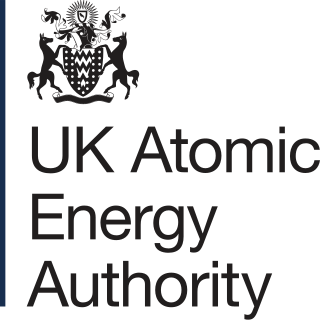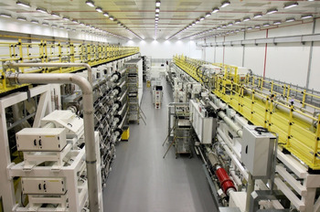
Chevaline was a system to improve the penetrability of the warheads used by the British Polaris nuclear weapons system. Devised as an answer to the improved Soviet anti-ballistic missile defences around Moscow, the system increased the probability that at least one warhead would penetrate Moscow's anti-ballistic missile (ABM) defences, something which the Royal Navy's earlier UGM-27 Polaris re-entry vehicles (RVs) were thought to be unlikely to do.

The United Kingdom Atomic Energy Authority is a UK government research organisation responsible for the development of fusion energy. It is an executive non-departmental public body of the Department for Energy Security and Net Zero (DESNZ).

The WE.177, originally styled as WE 177, and sometimes simply as WE177, was a series of tactical and strategic nuclear weapons with which the Royal Navy (RN) and the Royal Air Force (RAF) were equipped. It was the primary air-dropped nuclear weapon in the United Kingdom from the late 1960s into the 1990s.

The UGM-133A Trident II, or Trident D5 is a submarine-launched ballistic missile (SLBM), built by Lockheed Martin Space in Sunnyvale, California, and deployed with the United States and Royal Navy. It was first deployed in March 1990, and remains in service. The Trident II Strategic Weapons System is an improved SLBM with greater accuracy, payload, and range than the earlier Trident C-4. It is a key element of the U.S. strategic nuclear triad and strengthens U.S. strategic deterrence. The Trident II is considered to be a durable sea-based system capable of engaging many targets. It has payload flexibility that can accommodate various treaty requirements, such as New START. The Trident II's increased payload allows nuclear deterrence to be accomplished with fewer submarines, and its high accuracy—approaching that of land-based missiles—enables it to be used as a first strike weapon.

Chapelcross nuclear power station is a former Magnox nuclear power station undergoing decommissioning. It is located in Annan in Dumfries and Galloway in southwest Scotland, and was in operation from 1959 to 2004. It was the sister plant to the Calder Hall nuclear power station plant in Cumbria, England; both were commissioned and originally operated by the United Kingdom Atomic Energy Authority. The primary purpose of both plants was to produce weapons-grade plutonium for the UK's nuclear weapons programme, but they also generated electrical power for the National Grid. Later in the reactors' lifecycle, as the UK slowed the development of the nuclear deterrent as the cold war came to a close, power production became the primary goal of reactor operation.

In 1952, the United Kingdom became the third country to develop and test nuclear weapons, and is one of the five nuclear-weapon states under the Treaty on the Non-Proliferation of Nuclear Weapons.

Royal Ordnance Factories (ROFs) were munitions factories run by the UK government during and after the Second World War. The three main types of factories were engineering, filling and explosives, and these were dispersed across the country for security reasons. ROFs were the responsibility of the Ministry of Supply and later the Ministry of Defence until privatisation in 1987.

The US–UK Mutual Defense Agreement, or the 1958 UK–US Mutual Defence Agreement, is a bilateral treaty between the United States and the United Kingdom on nuclear weapons co-operation. The treaty's full name is Agreement between the Government of the United States of America and the Government of the United Kingdom of Great Britain and Northern Ireland for Cooperation on the uses of Atomic Energy for Mutual Defense Purposes. It allows the US and the UK to exchange nuclear materials, technology and information. The US has nuclear co-operation agreements with other countries, including France and other NATO countries, but this agreement is by far the most comprehensive. Because of the agreement's strategic value to Britain, Harold Macmillan called it "the Great Prize".
The Special Escort Group (Ministry of Defence Police) or SEG (MDP) are a specialised unit of the Ministry of Defence Police. It is primarily responsible for the movement of all nuclear weapons and Defence Special Nuclear Material within the United Kingdom.

Royal Naval Armaments Depot Coulport, shortened to RNAD Coulport, on Loch Long in Argyll, Scotland, is the storage and loading facility for the nuclear warheads of the United Kingdom's Trident programme.
Defence Nuclear Material Transport Operations refer to the movements of military Defence Nuclear Materials (DNM) within, to and from the United Kingdom. Defence Nuclear Material Transport Operations are also known as DNM Transportation; Defence Nuclear Material in transit; Nuclear movements; and DNM movements.

Trident, also known as the Trident nuclear programme or Trident nuclear deterrent, covers the development, procurement and operation of nuclear weapons in the United Kingdom and their means of delivery. Its purpose as stated by the Ministry of Defence is to "deter the most extreme threats to our national security and way of life, which cannot be done by other means". Trident is an operational system of four Vanguard-class submarines armed with Trident II D-5 ballistic missiles, able to deliver thermonuclear warheads from multiple independently targetable re-entry vehicles (MIRVs). It is operated by the Royal Navy and based at Clyde Naval Base on the west coast of Scotland. At least one submarine is always on patrol to provide a continuous at-sea capability. The missiles are manufactured in the United States, while the warheads are British.

A Gravel Gertie is a type of bunker designed to provide containment during the nuclear weapons assembly process, when the plutonium or highly enriched uranium "pit" is mated with the high explosive components and wired into the electronics of the warhead.
Royal Ordnance plc was formed on 2 January 1985 as a public corporation, owning the majority of what until then were the remaining United Kingdom government-owned Royal Ordnance Factories which manufactured explosives, ammunition, small arms including the Lee–Enfield rifle, guns and military vehicles such as tanks. It owned some 16 factories; and employed about 19,000 staff.

Burghfield Brook is a small stream in southern England. It rises in Wokefield Common between the Berkshire villages of Mortimer and Burghfield Common. It is a tributary of Foudry Brook, which it joins near Hartley Court Farm, just to the south of the M4 motorway.
The Teg is a small stream in southern England, in the county of Berkshire. It rises in Burghfield Common and flows northwards and then eastwards to join Burghfield Brook, a tributary of Foudry Brook.
Action AWE is a grassroots activist anti-nuclear weapons campaign/group launched in February 2013. Its aim is to increase and activate public opposition to the UK Trident nuclear weapons system, and depleted uranium warheads manufactured at AWE Burghfield, along with AWE Aldermaston.

Following the success of Operation Grapple in which the United Kingdom became the third nation to acquire thermonuclear weapons after the United States and the Soviet Union, Britain launched negotiations with the US on a treaty under in which both could share information and material to design, test and maintain their nuclear weapons. This effort culminated in the 1958 US–UK Mutual Defence Agreement. One of the results of that treaty was that Britain was allowed to use United States' Nevada Test Site for testing their designs and ideas, and received full support from the personnel there, in exchange for the data "take" from the experiment, a mutual condition. In effect the Nevada Test Site became Britain's test ground, subject only to advance planning and integrating their testing into that of the United States. This resulted in 24 underground tests at the Nevada Test Site from 1958 through the end of nuclear testing in the US in September 1992.

Kate Pyne was an English historian working at the Atomic Weapons Establishment (AWE), Aldermaston. Her work there included the writing of technical history on various aspects of the British nuclear weapons programme from its earliest days to the present time. Prior to taking a degree in Modern History at Queen Mary and Westfield College, University of London, she worked for many years in the aircraft industry.

The Orion Laser Facility is a high power laser facility based at the Atomic Weapons Establishment (AWE) on the former RAF Aldermaston site in the United Kingdom.
















